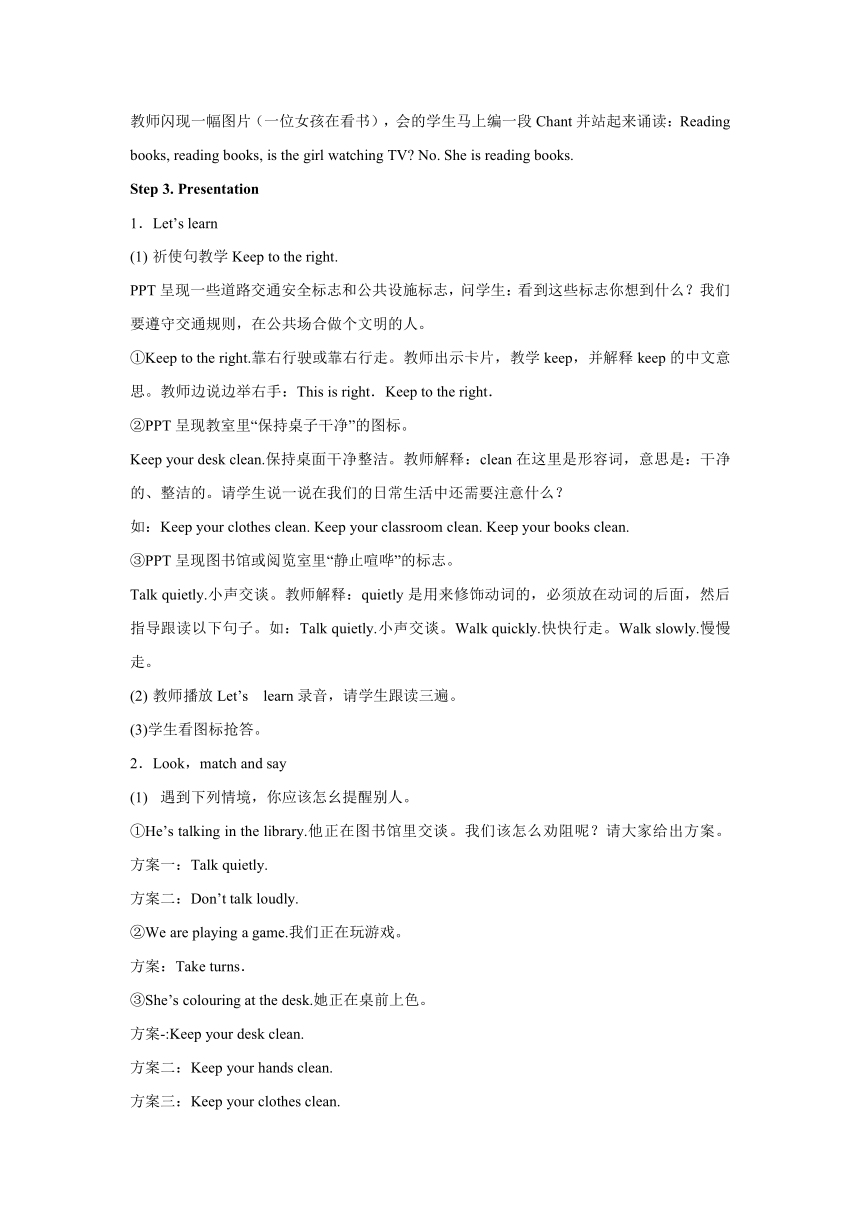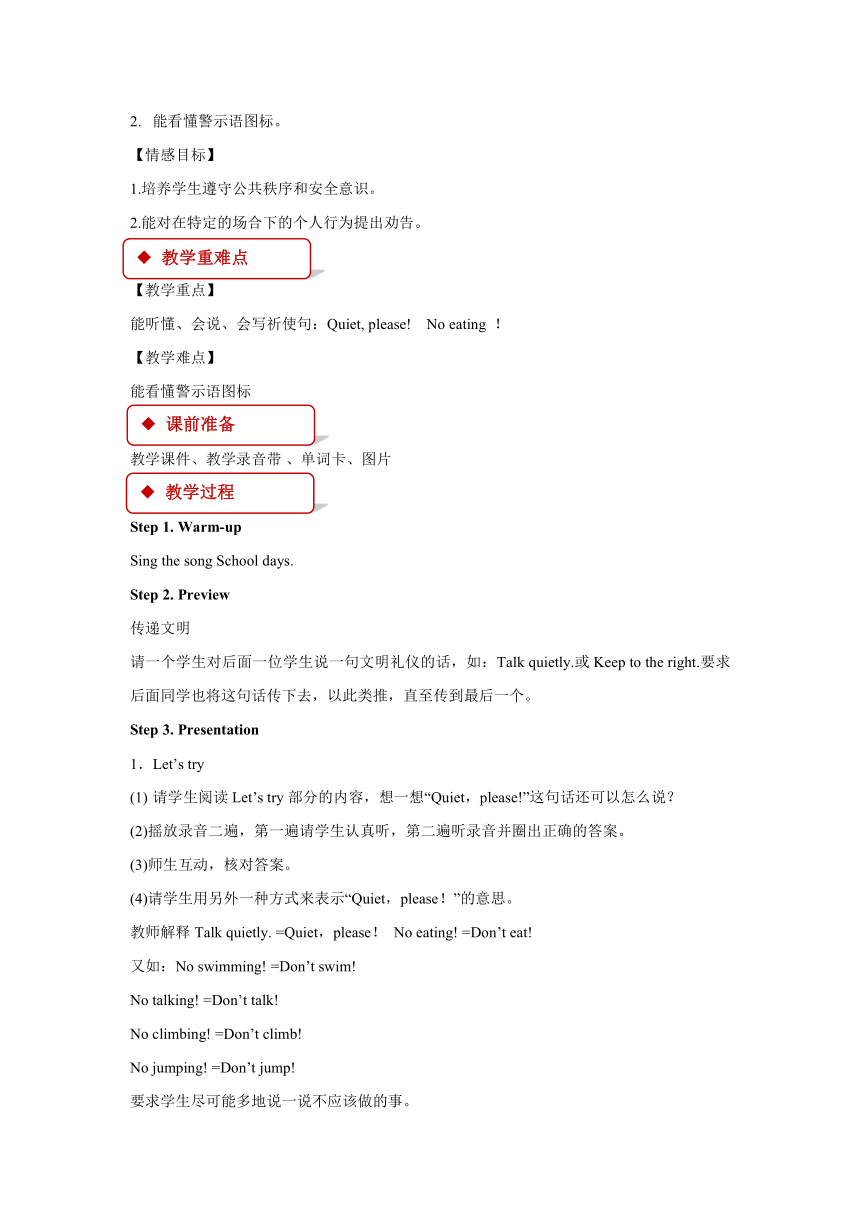Unit 6 Work quietly! PB 教案(3个课时)
文档属性
| 名称 | Unit 6 Work quietly! PB 教案(3个课时) |  | |
| 格式 | zip | ||
| 文件大小 | 138.5KB | ||
| 资源类型 | 教案 | ||
| 版本资源 | 人教版(PEP) | ||
| 科目 | 英语 | ||
| 更新时间 | 2018-03-13 19:12:16 | ||
图片预览




文档简介
Unit 6 Work quietly!
Part B
第一课时
本部分是人教版第六单元的Part B 部分。主要内容是运用祈使句讨论行为规范。 内容贴近生活,学生较为感兴趣。
【知识目标】
能听懂、会说、会写祈使句:Keep to the right. Keep your desk clean. Talk quietly. Take turns.
【能力目标】
1.能看懂警示语图标和标语。
2.能对在某个场景下的描述做出提示或警示。如:Talk quietly. Keep your desk clean等。
【情感目标】
教育学生要遵守日常行为规则,尊重他人的感受。
【教学重点】
能够正确地运用Keep to the right. Keep your desk clean. Talk quietly. Take turns.等句型。
【教学难点】
1.理解以ly结尾的副词是放在动词后修饰动词的。如:talk quietly,walk quickly。
2.理解祈使句使用的场合。
教学课件、教学录音带 、单词卡、图片
Step 1. Warm-up
1.free talk
2.学唱歌曲School days.
Step 2. Preview
Chant对抗赛
教师闪现一幅图片(一位女孩在看书),会的学生马上编一段Chant并站起来诵读:Reading books, reading books, is the girl watching TV No. She is reading books.
Step 3. Presentation
Let’s learn
祈使句教学Keep to the right.
PPT呈现一些道路交通安全标志和公共设施标志,问学生:看到这些标志你想到什么?我们要遵守交通规则,在公共场合做个文明的人。
①Keep to the right.靠右行驶或靠右行走。教师出示卡片,教学keep,并解释keep的中文意思。教师边说边举右手:This is right.Keep to the right.
②PPT呈现教室里“保持桌子干净”的图标。
Keep your desk clean.保持桌面干净整洁。教师解释:clean在这里是形容词,意思是:干净的、整洁的。请学生说一说在我们的日常生活中还需要注意什么?
如:Keep your clothes clean. Keep your classroom clean. Keep your books clean.
③PPT呈现图书馆或阅览室里“静止喧哗”的标志。
Talk quietly.小声交谈。教师解释:quietly是用来修饰动词的,必须放在动词的后面,然后指导跟读以下句子。如:Talk quietly.小声交谈。Walk quickly.快快行走。Walk slowly.慢慢走。
教师播放Let’s learn录音,请学生跟读三遍。
(3)学生看图标抢答。
Look,match and say
遇到下列情境,你应该怎幺提醒别人。
①He’s talking in the library.他正在图书馆里交谈。我们该怎么劝阻呢?请大家给出方案。 方案一:Talk quietly.
方案二:Don’t talk loudly.
②We are playing a game.我们正在玩游戏。
方案:Take turns.
③She’s colouring at the desk.她正在桌前上色。
方案-:Keep your desk clean.
方案二:Keep your hands clean.
方案三:Keep your clothes clean.
④They’re writing in class.他们正在教室里写作业。
方案-:Work quietly.
方案二:Don’t work loudly.
⑤They are walking on the bridge.他们正在桥上走。
方案一:Keep to the right.
方案二:Walk slowly.
要求学生将方案读一读,并有礼貌地说一说。
(2)学生完成Look,match and say部分的连线活动。
Step 4. Consolidation & Extension
小组活动:小组讨论并制定班规。
如:Keep your desk and chair clean.
Keep the blackboard clean.
Talk quietly.
Keep to the right.(注意提醒学生上下楼也要靠右走)
Step 5. Summary
师生共同总结本课所学内容。
Step 6. Homework
1.听录音,背单词。
2.查找资料,了解更多标识。
3.完成相关练习。
略。
第二课时
【知识目标】
能听懂、会说、会写祈使句:Quiet, please! No eating !
【能力目标】
能听懂 “let’s try”部分的录音,并根据录音内容选择正确的图片。
能看懂警示语图标。
【情感目标】
1.培养学生遵守公共秩序和安全意识。
2.能对在特定的场合下的个人行为提出劝告。
【教学重点】
能听懂、会说、会写祈使句:Quiet, please! No eating !
【教学难点】
能看懂警示语图标
教学课件、教学录音带 、单词卡、图片
Step 1. Warm-up
Sing the song School days.
Step 2. Preview
传递文明
请一个学生对后面一位学生说一句文明礼仪的话,如:Talk quietly.或Keep to the right.要求后面同学也将这句话传下去,以此类推,直至传到最后一个。
Step 3. Presentation
Let’s try
请学生阅读Let’s try部分的内容,想一想“Quiet,please!”这句话还可以怎么说?
(2)摇放录音二遍,第一遍请学生认真听,第二遍听录音并圈出正确的答案。
(3)师生互动,核对答案。
(4)请学生用另外一种方式来表示“Quiet,please!”的意思。
教师解释Talk quietly. =Quiet,please! No eating! =Don’t eat!
又如:No swimming! =Don’t swim!
No talking! =Don’t talk!
No climbing! =Don’t climb!
No jumping! =Don’t jump!
要求学生尽可能多地说一说不应该做的事。
2.Let’s talk
教师告诉学生:Tom and John are in the library. Please listen and try to choose the right answers.
① What does John say to Tom at first
A. Walk slowly. B.Talk quietly. C.No eating.
②What does John say to Tom at last
Keep your clothes clean. B.Keep your desk clean. C.Keep your room clean. (2)请学生合上书本听录音作答。
在学生回答的基础上,教师解释“Can I read the books here Yes. Of course.的意思。教师解释:征求别人是否可以做某事时可以说Can I…?如果表示同意,可以说:Yes: Of course. (4)快嘴先生:教师请一个学生说一句征求别人的话,由快嘴先生给予许可。
如:Can I eat here Yes.Of course.
又如:Can I talk quietly here Yes. Of course.
教师解释“I can show you the English books.”“Anything else ”的中文意思。
教师播放录音请学生跟读三遍。
分角色操练对话。
Match, say and act.
请学生将正确的文字描述与图片连线,然后说一说并演一演。
Step 4. Consolidation & Extension
1.活动:说一说,评一评
活动方式:教师说一种行为,请学生先重复老师说的,再评一评这种行为是否文明。如果不文明,请对他/她说一句提示语。
如:教师说:She’s eating lunch quietly.
学生说:She’s eating lunch quietly. She’s good!
又如:教师说:He’s talking loudly.
学生说:He-s talking loudly. He’s not good. Talk quietly!
又如:教师说:Keep to the right.
学生说:Keep to the right.lt’s good!
2.活动:编对话
教师出示图书馆、电影院和游泳池的图片,让学生围绕这些地方应该遵守的规则编一个对话。如:Sl:Look! Where are they
S2:They are in the library.
Sl:What are they doing
S2:They are reading books.
Sl:Oh,talk quietly in the library.
Step 5.Summary
教师引导学生总结本课所学的词汇和句型,鼓励学生提出问题。
Step 6.Homework
1.听录音,背B.Let’s talk。
2.查查过马路时我们应该遵循哪些规则。
3.预习下一课。
略。
第三课时
【知识目标】
能听、说、认读单词 “exhibition”, “say”, “sushi”, “teach”, “Canadian”, “Spanish”和词组 “have a look”.
能读懂 “Read and write”部分的对话。
【能力目标】
1.能听懂 “Let’s check”部分的录音,并根据录音内容选择正确的图片。
2.完成”Let’s wrap it up”部分的任务,总结现在进行时的构成及用法。
【情感目标】
能理解机器人产品的性能特点。
【教学重点】
1.能听、说、认读单词 “exhibition”, “say”, “sushi”, “teach”, “Canadian”, “Spanish”和词组 “have a look”.
2.能读懂 “Read and write”部分的对话。
【教学难点】
总结现在进行时的构成及用法
教学课件、教学录音带 、单词卡、图片
Step 1. Warm-up
Sing the song School days.
Step 2. Preview
活动:当学生唱完这首歌时,教师重复歌词内容,边重复边出示相应的单词卡片。
We come to work and play. We need to work and talk quietly. And listen every day. We need to keep our desks clean. We need to take turns to talk. Keep to the right. And keep to the right. And you will be a good student at school.
然后教师提问学生:Do you want to be a good student at school And how to be a good student Please say as much as you can.
学生根据校规或歌词提示,说一说怎么才能当个好学生。
如:Talk quietly..Work quietly. No eating in the library. No climbing. Keep our desks and chairs clean. Keep to the right.
Step 3. Presentation
1.Read and write
(1)教师介绍The world robot exhibition
T:Today I-ll introduce some robots to you. These robots come from many countries-Spain,Canada,USA...IJook! These are Spanish robots. Those are Canadian robots.出示单词卡片,让学生跟读。
(2)阅读理解并回答问题。
请学生阅读课文,然后选择最佳答案。
①The Canadian robot is________.
A. drawing pictures B.listening to music
②Asako is ______________.
A. eating sushi B.making sushi
③The Spanish robot is______________.
A. playing music B.listening to music
④Robin is__________kunf fu.
doing B.learning
在学生回答的基础上,教师做介绍:
The Canadian robot is drawing pictures.
Asako is making sushi.
The Spanish robot is playing music.
Robin is doing kung fu.
教师边介绍边将介绍的内容呈现在黑板上,并让学生一边阅读一边理解以上句子。
(4)教师讲解语言难点,请学生逐句跟读。
①I’m speaking Chinese.我说中文。
②Can you teach me 你能教我吗?
③I-ll show you.我表演给你看。
(5)阋读后指导朗读。
(6)教师播放录音,学生听,再一次帮助学生理解文本。
2.Fill in the blanks.
请学生独立完成Fill in the blanks.部分的练习,同桌核对后,全班学生共同核对。
Step 4. Consolidation & Extension
1.Let’s check
学生完成Listen and tick.练习,要求学生认真听,勾出听到的图。
(2)学生再次听音,然后回答问题并将答案写在横线上。
2.Let’s wrap it up
①学生完成Look and write.部分的练习,然后核对答案。
l.lt’s 7:00 a.m. We are eating breakfast at 7 0’clock.
2.I sometimes clean my bike on the weekend.I am cleaning it now.
3.It’s 9 p.m. They are sleeping now,but they often go to bed at 10 p.m.
核对完答案,教师要进一步强调“一般现在时”和“现在进行时”的不同用法。
Step5.Summary
教师引导学生总结本课所学的词汇和句型,鼓励学生提出问题。
Step6. Homework
1.听录音,模仿跟读。
2.完成相关练习。
略。
教材分析
教学目标
教学重难点
课前准备
教学过程
教学反思
教学目标
教学重难点
课前准备
教学过程
教学反思
教学目标
教学重难点
课前准备
教学过程
教学反思
Part B
第一课时
本部分是人教版第六单元的Part B 部分。主要内容是运用祈使句讨论行为规范。 内容贴近生活,学生较为感兴趣。
【知识目标】
能听懂、会说、会写祈使句:Keep to the right. Keep your desk clean. Talk quietly. Take turns.
【能力目标】
1.能看懂警示语图标和标语。
2.能对在某个场景下的描述做出提示或警示。如:Talk quietly. Keep your desk clean等。
【情感目标】
教育学生要遵守日常行为规则,尊重他人的感受。
【教学重点】
能够正确地运用Keep to the right. Keep your desk clean. Talk quietly. Take turns.等句型。
【教学难点】
1.理解以ly结尾的副词是放在动词后修饰动词的。如:talk quietly,walk quickly。
2.理解祈使句使用的场合。
教学课件、教学录音带 、单词卡、图片
Step 1. Warm-up
1.free talk
2.学唱歌曲School days.
Step 2. Preview
Chant对抗赛
教师闪现一幅图片(一位女孩在看书),会的学生马上编一段Chant并站起来诵读:Reading books, reading books, is the girl watching TV No. She is reading books.
Step 3. Presentation
Let’s learn
祈使句教学Keep to the right.
PPT呈现一些道路交通安全标志和公共设施标志,问学生:看到这些标志你想到什么?我们要遵守交通规则,在公共场合做个文明的人。
①Keep to the right.靠右行驶或靠右行走。教师出示卡片,教学keep,并解释keep的中文意思。教师边说边举右手:This is right.Keep to the right.
②PPT呈现教室里“保持桌子干净”的图标。
Keep your desk clean.保持桌面干净整洁。教师解释:clean在这里是形容词,意思是:干净的、整洁的。请学生说一说在我们的日常生活中还需要注意什么?
如:Keep your clothes clean. Keep your classroom clean. Keep your books clean.
③PPT呈现图书馆或阅览室里“静止喧哗”的标志。
Talk quietly.小声交谈。教师解释:quietly是用来修饰动词的,必须放在动词的后面,然后指导跟读以下句子。如:Talk quietly.小声交谈。Walk quickly.快快行走。Walk slowly.慢慢走。
教师播放Let’s learn录音,请学生跟读三遍。
(3)学生看图标抢答。
Look,match and say
遇到下列情境,你应该怎幺提醒别人。
①He’s talking in the library.他正在图书馆里交谈。我们该怎么劝阻呢?请大家给出方案。 方案一:Talk quietly.
方案二:Don’t talk loudly.
②We are playing a game.我们正在玩游戏。
方案:Take turns.
③She’s colouring at the desk.她正在桌前上色。
方案-:Keep your desk clean.
方案二:Keep your hands clean.
方案三:Keep your clothes clean.
④They’re writing in class.他们正在教室里写作业。
方案-:Work quietly.
方案二:Don’t work loudly.
⑤They are walking on the bridge.他们正在桥上走。
方案一:Keep to the right.
方案二:Walk slowly.
要求学生将方案读一读,并有礼貌地说一说。
(2)学生完成Look,match and say部分的连线活动。
Step 4. Consolidation & Extension
小组活动:小组讨论并制定班规。
如:Keep your desk and chair clean.
Keep the blackboard clean.
Talk quietly.
Keep to the right.(注意提醒学生上下楼也要靠右走)
Step 5. Summary
师生共同总结本课所学内容。
Step 6. Homework
1.听录音,背单词。
2.查找资料,了解更多标识。
3.完成相关练习。
略。
第二课时
【知识目标】
能听懂、会说、会写祈使句:Quiet, please! No eating !
【能力目标】
能听懂 “let’s try”部分的录音,并根据录音内容选择正确的图片。
能看懂警示语图标。
【情感目标】
1.培养学生遵守公共秩序和安全意识。
2.能对在特定的场合下的个人行为提出劝告。
【教学重点】
能听懂、会说、会写祈使句:Quiet, please! No eating !
【教学难点】
能看懂警示语图标
教学课件、教学录音带 、单词卡、图片
Step 1. Warm-up
Sing the song School days.
Step 2. Preview
传递文明
请一个学生对后面一位学生说一句文明礼仪的话,如:Talk quietly.或Keep to the right.要求后面同学也将这句话传下去,以此类推,直至传到最后一个。
Step 3. Presentation
Let’s try
请学生阅读Let’s try部分的内容,想一想“Quiet,please!”这句话还可以怎么说?
(2)摇放录音二遍,第一遍请学生认真听,第二遍听录音并圈出正确的答案。
(3)师生互动,核对答案。
(4)请学生用另外一种方式来表示“Quiet,please!”的意思。
教师解释Talk quietly. =Quiet,please! No eating! =Don’t eat!
又如:No swimming! =Don’t swim!
No talking! =Don’t talk!
No climbing! =Don’t climb!
No jumping! =Don’t jump!
要求学生尽可能多地说一说不应该做的事。
2.Let’s talk
教师告诉学生:Tom and John are in the library. Please listen and try to choose the right answers.
① What does John say to Tom at first
A. Walk slowly. B.Talk quietly. C.No eating.
②What does John say to Tom at last
Keep your clothes clean. B.Keep your desk clean. C.Keep your room clean. (2)请学生合上书本听录音作答。
在学生回答的基础上,教师解释“Can I read the books here Yes. Of course.的意思。教师解释:征求别人是否可以做某事时可以说Can I…?如果表示同意,可以说:Yes: Of course. (4)快嘴先生:教师请一个学生说一句征求别人的话,由快嘴先生给予许可。
如:Can I eat here Yes.Of course.
又如:Can I talk quietly here Yes. Of course.
教师解释“I can show you the English books.”“Anything else ”的中文意思。
教师播放录音请学生跟读三遍。
分角色操练对话。
Match, say and act.
请学生将正确的文字描述与图片连线,然后说一说并演一演。
Step 4. Consolidation & Extension
1.活动:说一说,评一评
活动方式:教师说一种行为,请学生先重复老师说的,再评一评这种行为是否文明。如果不文明,请对他/她说一句提示语。
如:教师说:She’s eating lunch quietly.
学生说:She’s eating lunch quietly. She’s good!
又如:教师说:He’s talking loudly.
学生说:He-s talking loudly. He’s not good. Talk quietly!
又如:教师说:Keep to the right.
学生说:Keep to the right.lt’s good!
2.活动:编对话
教师出示图书馆、电影院和游泳池的图片,让学生围绕这些地方应该遵守的规则编一个对话。如:Sl:Look! Where are they
S2:They are in the library.
Sl:What are they doing
S2:They are reading books.
Sl:Oh,talk quietly in the library.
Step 5.Summary
教师引导学生总结本课所学的词汇和句型,鼓励学生提出问题。
Step 6.Homework
1.听录音,背B.Let’s talk。
2.查查过马路时我们应该遵循哪些规则。
3.预习下一课。
略。
第三课时
【知识目标】
能听、说、认读单词 “exhibition”, “say”, “sushi”, “teach”, “Canadian”, “Spanish”和词组 “have a look”.
能读懂 “Read and write”部分的对话。
【能力目标】
1.能听懂 “Let’s check”部分的录音,并根据录音内容选择正确的图片。
2.完成”Let’s wrap it up”部分的任务,总结现在进行时的构成及用法。
【情感目标】
能理解机器人产品的性能特点。
【教学重点】
1.能听、说、认读单词 “exhibition”, “say”, “sushi”, “teach”, “Canadian”, “Spanish”和词组 “have a look”.
2.能读懂 “Read and write”部分的对话。
【教学难点】
总结现在进行时的构成及用法
教学课件、教学录音带 、单词卡、图片
Step 1. Warm-up
Sing the song School days.
Step 2. Preview
活动:当学生唱完这首歌时,教师重复歌词内容,边重复边出示相应的单词卡片。
We come to work and play. We need to work and talk quietly. And listen every day. We need to keep our desks clean. We need to take turns to talk. Keep to the right. And keep to the right. And you will be a good student at school.
然后教师提问学生:Do you want to be a good student at school And how to be a good student Please say as much as you can.
学生根据校规或歌词提示,说一说怎么才能当个好学生。
如:Talk quietly..Work quietly. No eating in the library. No climbing. Keep our desks and chairs clean. Keep to the right.
Step 3. Presentation
1.Read and write
(1)教师介绍The world robot exhibition
T:Today I-ll introduce some robots to you. These robots come from many countries-Spain,Canada,USA...IJook! These are Spanish robots. Those are Canadian robots.出示单词卡片,让学生跟读。
(2)阅读理解并回答问题。
请学生阅读课文,然后选择最佳答案。
①The Canadian robot is________.
A. drawing pictures B.listening to music
②Asako is ______________.
A. eating sushi B.making sushi
③The Spanish robot is______________.
A. playing music B.listening to music
④Robin is__________kunf fu.
doing B.learning
在学生回答的基础上,教师做介绍:
The Canadian robot is drawing pictures.
Asako is making sushi.
The Spanish robot is playing music.
Robin is doing kung fu.
教师边介绍边将介绍的内容呈现在黑板上,并让学生一边阅读一边理解以上句子。
(4)教师讲解语言难点,请学生逐句跟读。
①I’m speaking Chinese.我说中文。
②Can you teach me 你能教我吗?
③I-ll show you.我表演给你看。
(5)阋读后指导朗读。
(6)教师播放录音,学生听,再一次帮助学生理解文本。
2.Fill in the blanks.
请学生独立完成Fill in the blanks.部分的练习,同桌核对后,全班学生共同核对。
Step 4. Consolidation & Extension
1.Let’s check
学生完成Listen and tick.练习,要求学生认真听,勾出听到的图。
(2)学生再次听音,然后回答问题并将答案写在横线上。
2.Let’s wrap it up
①学生完成Look and write.部分的练习,然后核对答案。
l.lt’s 7:00 a.m. We are eating breakfast at 7 0’clock.
2.I sometimes clean my bike on the weekend.I am cleaning it now.
3.It’s 9 p.m. They are sleeping now,but they often go to bed at 10 p.m.
核对完答案,教师要进一步强调“一般现在时”和“现在进行时”的不同用法。
Step5.Summary
教师引导学生总结本课所学的词汇和句型,鼓励学生提出问题。
Step6. Homework
1.听录音,模仿跟读。
2.完成相关练习。
略。
教材分析
教学目标
教学重难点
课前准备
教学过程
教学反思
教学目标
教学重难点
课前准备
教学过程
教学反思
教学目标
教学重难点
课前准备
教学过程
教学反思
